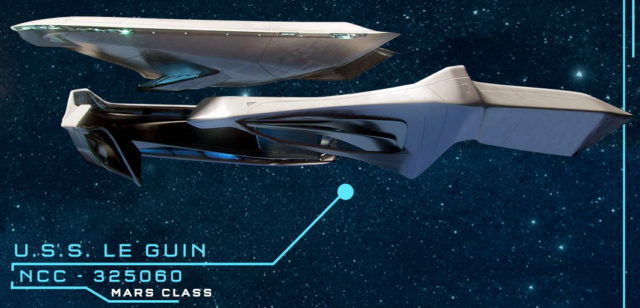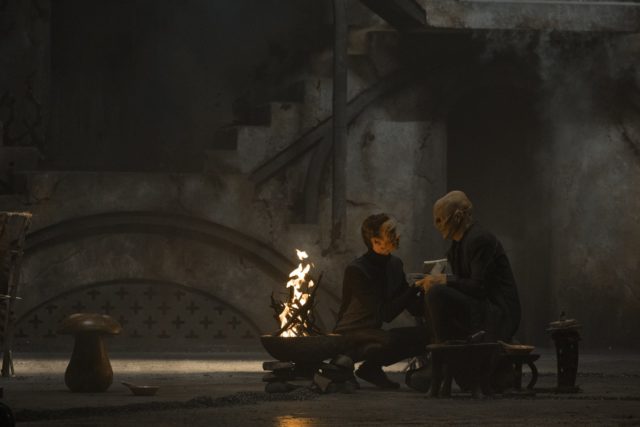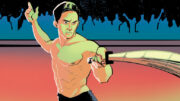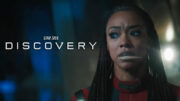WARNING: This article discusses spoilers for Star Trek: Discovery season 3.
Before the third season of Star Trek: Discovery began, the “What is The Burn?” mystery had been established as the main plot arc. Now the showrunners are talking about developing this arc, and what inspired it.
Le Guin’s Omelas inspired the story of Su’Kal and The Burn
When the crew of the USS Discovery arrived in the 32nd century they found a fractured Federation where warp travel had been severely limited due to a lack of dilithium. Michael Burnham made it her mission to solve the mystery of The Burn, leading them to the Verubin Nebula and a crashed Kelpien ship. The sole survivor, Su’Kal, had remained on the ship for a century awaiting rescue, living in a holographic world created by his mother. The final episodes of the season had the surprising revelation that it was Su’Kal as a child who caused The Burn through his unique link to dilithium. His emotional outburst at the loss of his mother had rippled through subspace, rendering dilithium inert throughout the Federation and beyond.
In a post-finale live chat with Gold Derby, Discovery executive producers and co-showrunners Michelle Paradise and Alex Kurtzman discussed the season, including developing the story of The Burn. Kurtzman discussed how he and Michelle developed the story during walks together before bringing together the writers’ room:
In the early conversations, the [Ursula K. Le Guin] short story [The Ones Who Walk Away from Omelas] came up, which is a very famous science fiction story. And at the heart of that story is a child, which is centered around a village. It’s not exactly a one-to-one analogy, because our story is different. But it was an inspiration. When we got the idea that this was actually all caused by a child. I think that came out of the instinct that we wanted the answer to be something you didn’t see coming or didn’t expect, but made sense once you got there. In order for that to work, you have to know where you’re going and you have to plant flags along the way that the audience is either consciously or unconsciously taking in, so that when you get to that reveal, you realize, ‘Oh, it all added up to something.
We knew that there was going to be a dreamworld. We knew that it was his own version of The Matrix. We didn’t know exactly what it would look like, and it took a full season to actualize it and the rules and the logic for it. But we knew from the beginning that that’s where we wanted to go.
The Ones Who Walk Away from Omelas is one of Ursula K. Le Guin’s most famous stories and often used in classrooms discussing ethics in literature. The 1973 short story tells the tale of the utopian city of Omelas, which includes a dark truth. From Wikipedia:
Everything about Omelas is so abundantly pleasing that the narrator decides the reader is not yet truly convinced of its existence and so elaborates upon the final element of the city: its one atrocity. The city’s constant state of serenity and splendor requires that a single unfortunate child be kept in perpetual filth, darkness, and misery. The child is helpless: anything kind, small or big, will turn Omelas from a utopia into a dystopia. The terms are strict.
As a nod to Le Guin’s contribution to the season, one of the 32nd century Federation ships was named in her honor and mentioned in the episode “Scavengers.” The award-winning author passed away in 2018 and was never able to see herself added to Trek canon. After the episode mentioning the USS Le Guin aired, the late author’s estate sent out a tweet saying she would be “would be tickled!” by the reference.
#StarTrekDiscovery S3E6 introduces the USS Le Guin. Ursula would be very tickled! Thank you Peter O'Brien for bringing this to my attention and (I assume) writer/producer @acofell for making it happen. pic.twitter.com/vxJjetoY1Q
— Ursula K. Le Guin (@ursulaleguin) December 17, 2020
And last week CBS shared concept art for the USS Le Guin and other 32nd century Federation ships.
During the same live chat, Kurtzman’s co-showrunner Michelle Paradise talked about coming up with an unconventional answer for The Burn, and how it tied into the theme for the season:
It was something that we talked about from the beginning of the season, in terms of what was The Burn, and what would have caused it. And one of the things that Alex and I were talking about very early on was: What does it mean?… One of the things that we were exploring a lot in season three was this notion of connection and disconnection. And when we were getting to the end of the season, it was, ‘What is the greatest metaphor or symbol of disconnection that there is?’… That idea of disconnection, coming to a very emotional moment, and a disconnect between this child and his mother, between any two people. What is the thing that that is the most emotional? That’s what we were digging at as a symbol of disconnection. We couldn’t think of anything that was more emotional than that.
And the idea that this world was also created by his mother’s love for him, and trying to make his world a better place, even in her absence. And the ways in which she was continuing to reach for him are many of the ways in which our characters have been reaching for one another over the course of the season. The ways in which the characters who were born into this world – Admiral Vance and Book and all of these other characters who have been adrift from one another, and disconnected, reaching and trying to connect. We wanted the world that Su’Kal lived in to be symbolic of that.
Keep up with all the news and reviews from the new Star Trek Universe on TV at TrekMovie.com.









The source of the Burn was initially a disappointment to me, but upon further reflection it is a very poignant and creative sci-fi based solution to the season’s climax. How many times have I read complaints about one dimensional villains in recent Trek stories and wanting something different and more rooted in science fiction. This was really unique, and I like that it had a connection to a classic sci-fi story. I actually also appreciate the Technobabble explanation for it. That was very TNG-like. Discovery still falls short for me in a lot of areas-mainly from a visual perspective. But I think the Burn storyline was pretty cool…
I agree – in fact I just watched ‘The Omega Directive’ last night, the VOY episode feat. an early theory for The Burn and found myself wondering if this would have been a better reveal.
I think the idea that an innocent child would be the cause of such a destructive galaxy-changing event is very TOS/early-Tng.
My issue was that it felt too stretched out, like a two-parter story made to fill a 13ep series. There was no misdirection or mystery into the actual investigation of the cause – once they had the sensor data and triangulated the location of the source that was it. There were many fan-theories pointing to what the source could be, but these should have been expressed more on screen leading the audience (and the crew of Discovery) into thinking it was something else entirely – rather than merely being left for fans to discuss in message boards.
As the main plot line for the season it felt very unidirectional – whereas with Picard S1 you never really knew where it was heading, same with the later seasons of DS9. If your going to have a story fill an entire season and keep the audience invested in the outcome I expect more twists and turns :/
Reading anything by Ursula K. Le Guin is infinitely more rewarding than watching Disco or Picard.
The producers talk a big game about this and that, but so far they haven’t produced anything that holds a candle to their own ambitions let alone great works of science fiction such as The Left Hand of Darkness, The Dispossessed, or even The Word for World is Forest.
The Ones Who Walk Away from Omelas is a revered piece of science fiction and honestly it breaks my heart to see Kurtzman and Co. say they were inspired by it. I’ve read the short story. I don’t understand what kind of parallel they are trying to draw.
Going forward I think I might just stick to reading science fiction novels rather than wasting my time watching the work of these posers and fakers. Season 3 was a huge disappointment.
I read that short story as a pre teen and frankly it’s one of the science fiction stories that helped shape me as a human. I enjoyed this season of Discovery more than the others, but not once did I make the connection between this season end arc and that short story. Some of the difference lies in the medium/time/age space of course. I might’ve written things differently, but who am I kidding. I don’t write for television shows reaching millions of people.
Well, OK, but that story bears little relation to Disco’s insipid dilithium tantrum.
A small child finds his entire family dead, bar his mother, who dies in front of him, leaving him entirely alone. Supposed Star Trek fans characterise the child’s all-consuming grief and fear as an “insipid tantrum”.
I don’t even disagree with your point, just really tired of this relentless, petty negativity.
Great! The Burn and its origin has really grown on me. I think it is so much better than your average worn-out villain or mad scientist trope.
AND it absolutely does connect to our present Covid situation. Like so many kids, Su’Kal is left home alone in a (complex) home schooling program. We are all waiting for the outside world to come back to us (in places with full lockdown in place) but it never comes… In reality, his mother could die of Covid-19 and a kid be left home alone for good in this situation. It is a very topical issue GOOD Trek has always been proudly tangling. Disconnection with the outside world, grief and fear of loss…
I don’t know if the story would have been so poignant had the pandemic not occurred, but I was certainly affected by that coincidental relation to current events. “Waiting for the outside world to come back to us,” and the reconnection that will follow is a great way to describe it all.
Fully agreed, and I loved the fact that Su’Kal was not a mustache-twirler. There were parts of the finale I disliked — but Su’Kal wasn’t among them, not at all.
I do think the story of the Burn’s origin was a smidge pedestrian considering how it killed billions of people and condemned billions more to horrible lives, but I’m just glad it wasn’t related to Michael or Michael’s mother or anything Discovery previously did or anything like that. I appreciate that it was a wholly original and new thing. Was it a perfect choice? No, but it was a new choice, and for that I am grateful.
So, Ursula K. became Su’Kal? ;-)
People Who Need People! Connection! “That’s a fine enough line for a bumper sticker or an inspirational poster. I’m not sure it entirely suffices as the thematic underpinning of an entire season of television, in part because it’s such an incredibly obvious thing to say. The idea of building relationships between cultures… has been baked into Trek from the start, and, while it occasionally fumbled its way into something interesting, Discovery has nothing really to add to the conversation. Because Discovery isn’t about saying anything. It’s about feeling things. Mostly nice things. Because nice things? Are nice… Discovery asks nothing of the viewer but their minimal attention. There are no challenges here, and only the most fleeting interest in making anyone uncomfortable. There’s no real friction and almost no ambiguity. This is not a show that earns connections. It’s a show that simply assumes they exist, and then simply waits to bask in the adulation of that assumption.” – Zach Handlen, AV Club
Some random thoughts:
So why didn’t the dilithium planet burn too?
I like Bill Irwin, but I couldn’t tell it was him under that makeup. Maybe he can come back as another (more recognizable) character.
They saved R2!
The ridiculous turbo rollercoaster space is about the dumbest thing I have ever seen. Visual reboot please! I liked Evil Jake Weber, but it was inevitable that he had to go. Maybe he will survive turbo rollercoaster space and come back even meaner.
I thought they couldn’t make the uniforms worse. I was wrong.
So, if this was inspired by a work of Ursula K. LeGuin, can’t we just get a dramatized version of that?
Can’t wait to see what they will do to Star Trek next season! (My bet is a pandemic since SPS wouldn’t let them do it on Picard.)
>;>}
It wasn’t the dilithium itself that burned. Dilithium usually moderates the matter/antimatter reaction in warp cores. When it went inert the uncontrolled matter/antimatter reaction made the ships explode.
Excuse my inaccuracy. Why didn’t the dilithium planet go inert too?
(But it doesn’t really matter. There is no consistency or sense to STD.)